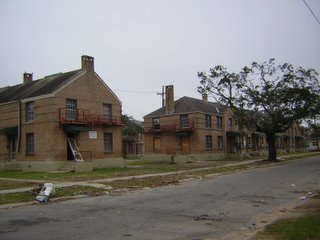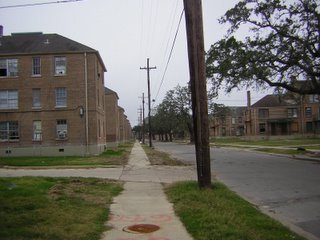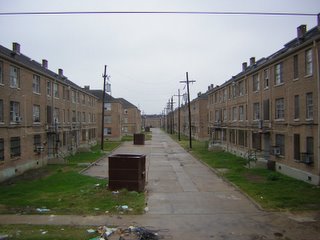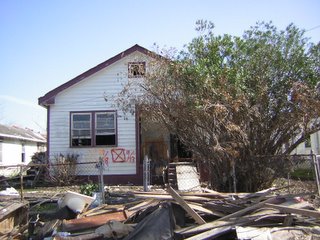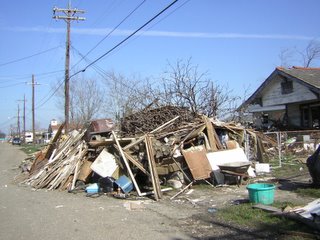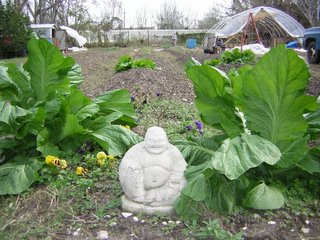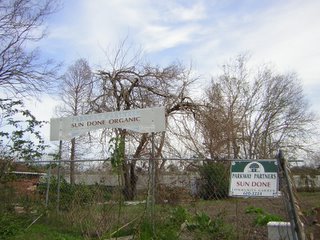Yesterday I attended the church services of Pastor Bruce Davenport. Though only about ten of his congregation members were around for it, about twenty Common Grounders came out to take a day off from house gutting and to hear some lord praising. It was like nothing I have ever experienced before. I filmed the entire service at the request of the Pastor. He seems to love the idea of people outside of New Orleans seeing every last bit of the city through the lens of my camera. 'Spread that movie wide,' he says to me, grinning widely. Insh'allah, I think. God willing, I will.
During the service his wife played the most interesting and inspiring role. She got up a few times to dance and sing, led the chorus of 'Amen' and 'Praise Jesus' calls, and spoke like the lord Jesus had occupied her soul. She talked quickly, her eyes closed, her body swaying to a rhythm she gradually made the rest of us feel. I nodded my head.
'We don't need a FEMA, 'cause we have the spirit of the Lord. We don't need a President when we have the spirit of the Lord. We don't need a government when we have our faith to guide us and give us strength.'
Well, people around here would do well to have some help from FEMA, the President and the government. But what she was saying, and what Common Ground was founded for and the assumption it operates by, is, I think, that the government has never and probably will never come out to the 9th or the 7th wards (predominately low income communities of color) to do anything but arrest and beat people. And she was also saying that they're help isn't necessary because the people there have built their lives, founded their very existences on mutual aid and community support networks. Hard work and, according to the Davenports, faith with a capital 'F' have led these people to the places they are today. The president and the corrupt, money hungry government has had little to do with it. No one outside of these communities helped these people before the storm, and Sister Davenport seems to think that most people didn't expect them to come through during or after it, either.
That doesn't mean that the government should not be held responsible for their crimes in the Delta. It just means that people don't have too much optimism about that actually happening. Take a crazy example: the 17th street bridge.
Pastor Davenport, after the sermon and after treating us to lunch, took us on a tour of some of the lesser known and crazier regions of the city. The 17th street bridge separates a bourgeosie, mostly white neighborhood from a much wealthier, largely commercial and business district. The upper-middle class community, Lakeview, has never in the history of its existence experienced troubles beyond wind and rain damage in hurricanes. They have levees and a pumping system to protect them. So they must have been awfully surprised when water began flooding their parrish, eventually reaching 8 feet in some places. The homes we drove past were completely destroyed, just like the homes in the upper 9th near the community center: a nasty, yellow ring on the outside of homes demarcates where the water finally rested and stood sometimes for days, rotting and poisoning everything within its reach.
What happened? The richer people on the other side of the bridge decided that, as the water began to reach their doorsteps, something had to be done. So they started pumping water from their side of the bridge into Lakeview, on the other side. Mysteriously, as this happened, the pumps on the Lakeview side were overcome and the crew there deserted. So then instead of pumping some of the rising water out, the people in Lakeview were receiving water from the other side of the bridge and unable to pump any themselves. I asked Pastor Davenport if he thought that someone responsible for this decision was liable to be charged with a crime. He laughed. 'Money runs this city, dear,' he said, 'and these people, even though they are murderers, they will get away scot free like always.'
Apparently there were quite a few deaths in Lakeview because of the decision. On top of all of this, someone from the business district, presumably the parrish councilman, called in the National Guard to prevent Lakeview residents from crossing the bridge. So as the water was pumped into their community, destroying their homes and endangering their lives, people from Lakeview, attempting to get to dry land literally hundreds of meters away, were told that they would be shot on the spot if they walked further. Dry land, water and food was a five minute walk away, and these people were kept from accessing it by men in uniforms and bearing guns they had helped to purchase with their tax dollars.
Then we went to the 9th ward. 'I am about to show yall something you won't believe even when you see it,' the Pastor said. And true to his word, it was like nothing I'd ever seen in my life. And there were crimes committed here, too. It was entirely a man-made catastrophe in the lower 9th. First I will give a brief history of the neighborhood, describe the scene as it looks today and then briefly how it happened---and how it could have been avoided.
Driving through the lower 9th, I asked the Pastor about the community's history. Apparently it's one of the oldest independent black neighborhoods in New Orleans. Most of the homes there are owned by residents, who are all people of color. According to the Pastor, the lower 9th is the place that people in the projects aspire to live. 'When you make it out of the projects,' he said, 'you come here.' So people are very proud of their community. There are (or were) tons of black owned businesses, lots of homeowners who worked years to afford their own property, and the community is tightly knit and has a culture all its own. When we got out of the van to survey the damage from ground level, the Pastor advised us to 'listen to the silence'. Once a loud community bursting with life and the sounds of children and young people in the streets, the only noises I could hear were the occasional chirping of a distant cricket. Otherwise, total silence. Where about thirty thousand people had once laid their heads and lived their lives there was now only total destruction.
The largest levee bust is about a two hundred yard distance from where the first row of houses was. The levee was built to protect the city from overflow of the manmade canal waters. The canal runs between a large lake and the Mississippi river; it was perhaps the stupidest idea engineers have ever had. But I think it probably had less to do with engineering stupidity and more with that of the money hungry capitalists who thought it a great way to create a shortcut for trading ships. In any event, the levee and the canal run right up against the lower 9th ward community, though you couldn't tell today because the first five or six rows of houses are completely gone. Gone or moved off of their foundations, hundreds of meters away from where they once stood, stopped only by a brick house or a deeply rooted, hundred year old tree. The first few rows of houses are unrecognizable: the debris looks like it was produced by a ten ton bomb. The sheer power of the water that flooded the area after the levees burst probably carried with it a similar force.
The whole neighborhood is fucked. I think I saw two of about one thousand homes that could, in theory, be gutted and rebuilt. The rest of them are completely gone, lost causes. But people are returning to look at the damage and they all say they will rebuild. I saw a sign the other day, handpainted and hanging in front of someone's house, that read: 'We have survived the French, the Spanish, the Germans and the English. We have survived slavery, institutional racism and criminal neglect. We will survive this.' That seems to be the general feeling here. There are signs everywhere reading: "NO BULLDOZERS!" The city is going around trying to demolish and confiscate people's property. A local lawyer has put together a coalition that is trying to fight this. After seeing the damage, I know it will be a difficult battle to win.
So how did the levees bust? According to the Pastor, it had much to do with a stupid decision, made by someone in charge of such things but whose name will surely never reach the public. Along the canal there are a series of dams, or 'locks' as they are called here. These locks are opened and shut to allow for ships to cross the canal and in the interest of controlling the amount of water going in or out.
In this case the wrong (or right?) decision was made. The dams were locked when they should have been kept open. Had they been left open, the water that eventually burst the levees would have flooded into the Mississippi. But they were locked and so all of that water pushed and pushed until the inadequate levee could not take the force, bursting and unleashing a pandora's box of hell onto the defenseless lower 9th beneath it. Quite a few people think that the lower 9th was the sacrificial lamb of fearful ignorance; no one knew what would have happened had the Mississippi been flooded with that extra water, and so they took the chance and deposited its uncertainty on the lower 9th. Luckily, most people who live there had the sense to get out well before the levee burst. There were few confirmed deaths there considering the damage, but pretty much everyone is convinced that lots of the 3,700 thus far unaccounted for people are rotting under the debris.
Still, after all of this, the words that stuck with me last night as I went to sleep were Pastor Davenport's opening comments during his sermon. 'This, too,' he said, 'shall pass.'
